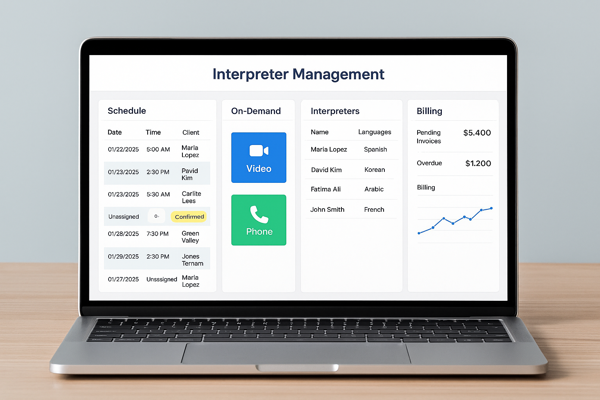Why Manual Interpreter Scheduling is Costing Your Organization Time and Money

Interpreter scheduling plays an important role in hospitals, courts, schools, and language service providers. Yet many organizations still rely on outdated manual methods like spreadsheets, phone calls, and endless emails to coordinate assignments. What seems simple on the surface often leads to frustration behind the scenes.
The truth is, manual interpreter scheduling is inefficient, error-prone, and expensive. It consumes valuable staff hours, creates gaps in service delivery, and places unnecessary strain on interpreters and clients alike. Over time, these inefficiencies translate into lost revenue, compliance risks, and damaged relationships.
As the demand for fast, reliable multilingual support grows, organizations that continue to depend on manual processes are finding themselves at a disadvantage. Modern interpreter management solutions are proving to be the smarter, more cost-effective alternative.
The Hidden Inefficiencies of Manual Interpreter Scheduling
1. Time-Consuming Coordination
Manually calling interpreters to check availability or updating multiple spreadsheets can take hours every day. Staff end up juggling phone numbers, calendars, and documents instead of focusing on higher-value tasks.
Example: A hospital administrator might spend an entire morning coordinating interpreters for patient appointments, only to redo the process when cancellations or emergencies arise.
2. Higher Error Rates
Manual data entry increases the risk of:
- Double bookings.
- Missed assignments.
- Incorrect language pairings.
- Overlooking interpreter qualifications.
Even small errors can cause major service disruptions, particularly in sensitive sectors like healthcare and justice.
3. Lack of Real-Time Visibility
With manual scheduling, managers can’t instantly see who’s available, where gaps exist, or how workloads are distributed. This makes it harder to respond quickly when urgent requests come in.
4. Strain on Interpreter Relationships
Interpreters expect transparency and fairness in how assignments are distributed. Manual systems often lead to misunderstandings, delayed payments, and missed opportunities, which can result in interpreter turnover.
The Financial Costs of Manual Scheduling
Manual scheduling doesn’t just waste time, it hits your bottom line.
1. Increased Administrative Costs
Staff hours spent on scheduling are hours that could be used for client relations, business development, or compliance. Multiply those hours across a year, and the cost of inefficiency quickly adds up.
2. No-Shows and Service Gaps
When interpreters are double-booked or communication breaks down, clients are left without language support. This can result in:
- Canceled appointments.
- Court delays.
- Fines or penalties for non-compliance.
- Loss of client trust.
3. Revenue Leakage
Every missed booking or incorrectly billed appointment is lost revenue. Manual systems often fail to capture:
- Overtime charges.
- Travel reimbursements.
- Late cancellations.
4. Difficulty Scaling
As demand grows, manual scheduling simply can’t keep up. Instead of scaling profitably, organisations hit a wall, with administrative costs skyrocketing while efficiency plummets.
The Compliance Risks of Manual Scheduling
Interpreter services often take place in highly regulated environments. Manual processes can leave organizations vulnerable to compliance issues.
- Healthcare: HIPAA requires strict patient data protection. Manual notes and spreadsheets can expose organizations to data breaches.
- Legal: Courts and law enforcement require certified interpreters. Manual scheduling makes it easy to assign the wrong level of interpreter, risking mistrials or appeals.
- Government contracts: Many agencies demand transparent reporting and audit trails, which manual systems struggle to provide.
Failure to comply can result in contract loss, fines, or reputational damage.
Why Modern Organizations Are Moving to Interpreter Management Solutions

1. Automation of Scheduling
An interpreter management solution like Interpreter IO uses smart algorithms to match interpreters instantly based on:
- Language pair.
- Availability.
- Certification level.
- Location (for in-person assignments).
This eliminates hours of back-and-forth communication and reduces scheduling errors.
2. On-Demand Interpreting Access
With integrated Video Remote Interpreting (VRI) and Over-the-Phone Interpreting (OPI), clients no longer need to wait days for a booking. They can connect to an interpreter within minutes—vital for healthcare, courts, and emergency services.
3. Streamlined Billing and Payroll
Modern systems capture every assignment detail like duration, travel time, cancellations automatically. This ensures:
- Accurate invoices.
- Transparent interpreter pay.
- No lost revenue from unrecorded services.
4. Data Security and Compliance
Cloud-based platforms provide:
- Encrypted data storage.
- Audit trails for every booking.
- Compliance with HIPAA, ISO 27001, GDPR, and justice-sector standards.
5. Improved Interpreter Experience
Interpreters benefit from mobile-friendly portals where they can:
- Accept or decline jobs in real time.
- Track payments.
- Upload compliance documents.
- Manage their calendars on the go.
This reduces turnover and builds stronger relationships between organizations and their interpreter networks.
Real-World Example: The Cost of Manual vs Automated Scheduling
Scenario 1: Manual System
A mid-sized hospital books 200 interpreting appointments weekly. With manual scheduling, staff spend an average of 20 hours per week on coordination. At $30/hour, that’s $31,200 annually just in admin costs—before factoring in no-shows or compliance risks.
Scenario 2: Interpreter IO Solution
By switching to Interpreter IO, the same hospital automates scheduling and reduces admin time by 75%. Staff hours drop to 5 per week, saving $23,400 annually. Plus, the hospital gains real-time visibility, reduced errors, and better patient outcomes.
Signs Your Organization Has Outgrown Manual Scheduling
- Your staff are spending more time scheduling than serving clients.
- You’ve experienced interpreter no-shows, double bookings, or missed assignments.
- Billing and payroll errors are common.
- You’re struggling to track interpreter qualifications or compliance documents.
- Your clients are requesting faster turnaround times than you can deliver.
If any of these sound familiar, it’s time to invest in a modern interpreter management solution.
How Interpreter IO Solves These Challenges
Interpreter IO is a cloud-based interpreter management solution designed for LSPs, hospitals, courts, and government agencies. With our platform, you can:
- Automate scheduling with AI-driven matching.
- Provide on-demand access via video and phone interpreting.
- Ensure compliance with secure, encrypted data handling.
- Streamline billing and payroll with automated invoicing.
- Support interpreters with mobile-friendly portals and transparent pay tracking.
- Generate insights with reporting dashboards for demand forecasting and performance tracking.
By moving away from manual systems, organisations save time, reduce costs, and deliver higher-quality interpreting services.
Ready to Stop Losing Time and Money?
Manual interpreter scheduling is holding your organization back. It wastes staff hours, risks costly errors, and frustrates both clients and interpreters. In 2025, the most successful organizations are those embracing smart, automated interpreter management solutions.
At Interpreter IO, we make it easy to modernize your interpreting operations. Our platform combines automation, compliance, and ease of use, so you can focus on delivering world-class multilingual support.
Book a Demo with Interpreter IO today and discover how much time and money your organisation can save by moving beyond manual scheduling.
